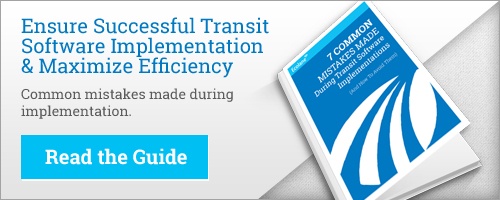Doing more with less has been a job requirement for as long as I’ve been in the transit industry. No matter what the funding source, whether it be federal, state or local, in most places transit agencies are consistently being called on to provide more services while revenues to cover their costs are harder to come by. Implementing transportation software can help with that.
Gaining Efficiencies to Reduce Costs
It’s a given that agencies have to become more financially sustainable in order to continue to offer their services. It requires agencies to find efficiencies and do business differently than they did in the past. Generally speaking, agencies need to continually evaluate how they’re operating to both reduce costs and increase riders and revenues.
Scheduling and Performance Evaluation
In other industries, companies reduce costs by simply laying off portions of their workforce. But in transit, it’s no secret that most agencies are having difficulty in finding good candidates to train and help put into service on the street. So even though labor is an agency’s top expense, letting people go to save costs is usually not preferred. So instead of reducing labor costs, evaluate how your employees are scheduling and performing their trips. You can significantly improve your bottom line if you can provide the same services with a reduction in overtime, idle time, fuel costs and vehicle mileage.
Understand Trip Demand
Many agencies know ahead of time when they’re going to be providing paratransit trips based on advance trip booking requirements. And for those that provide same-day service, they understand their trip demand based on historical numbers. So how closely does your trip demand align with your trip capacity? A good scheduling software will not only efficiently group and schedule trips together, but it will also tell you exactly where you have excess capacity in the day compared to times when you need to shift capacity to meet demand. In short, knowing in advance exactly what future days look like can help plan driver hours so you can avoid paying excess (and expensive) overtime costs.
Automatic Scheduling Systems
What about when people call and cancel their trips just before you went to pick them up? Fully automated scheduling systems can immediately re-optimize the rest of the trips for that day following a cancellation or no-show. In many cases, the result is that the actual system efficiency performed on the day of service is even better than the efficiency planned on the day before due to this continuous schedule optimization.
An automated system doesn’t just help with planning for normal days of service – it also helps in emergency situations, for example when a driver has to put in a road call. A good scheduling system can help re-route that driver’s trips to different drivers, potentially negating the need to pull out a spare driver to finish the route and avoiding those costs.
Attracting New Riders to Increase Revenues
So we see that technology can help cut costs, but what about ways to increase revenues to help remain fiscally sustainable? We can look for ways to get more funding, but frankly, ridership needs to increase for paratransit to remain sustainable. I’ve never heard a transit person say to me, “We’ve got too many riders,” or, “We’ve had to start a waiting list.”
Understand and Meet Rider Expectations
What makes a person want to ride your paratransit service? Some people do it out of necessity, of course. They can’t get around without assistance, such as the use of a wheelchair lift. But when people do have a choice, why should they choose you? After all, new on-demand services are ubiquitous, like Uber and Lyft. Many transit agencies are choosing to partner with these companies because it’s cheaper to send out the trip rather than to use their expensive drivers and large vehicles if they’re not sending a group of customers that direction. And many clients are choosing to go directly to these providers, bypassing the transit agency altogether. Why? They’re convenient, reliable, relatively inexpensive, and they know what they’re getting.
Optimize Rider Experience
Focusing on these outcomes, transit can provide a similar riding experience. When your clients book a reservation, can you give them definite windows of time in which you’ll be picking them up and dropping them off? Are you able to schedule a client’s ride when they want to ride, rather than when you think you may be able to slot them in? Do your drivers hold to consistent policies and procedures to make sure they’re giving everyone a consistent ride? Do they form solid relationships with their passengers over time out of a concern for the clients’ welfare?
How to Get There from Here
Software can’t do everything. That’s why you hire good people. But giving your people the best tools to do their work can certainly affect both sides of the balance book. Getting better service on the street, and then leveraging that better service to attract new clients moves agencies toward long-term fiscal sustainability.
--
Real-time scheduling and optimization – service transparency – reduction in costs – accurate reporting – better customer service and outcomes. Can your software do that?
Schedule a time to talk with us today about how Ecolane can help you do more with less, and get you on the road towards better fiscal sustainability.
About the Author:
 Kevin Dow is our Project Support Office Administrator. He has a proven record of project management in the public transportation industry and was recruited in 2013 by Ecolane to extend the level of services provided to the company’s client base. His background in education, non-profit agencies, technology procurement, standards, and policies make Kevin a valuable resource to further the objectives of the organization. His responsibilities focus on the evaluation and management of the implementation process for Ecolane, regional and local staff training, identifying added value initiatives, and increasing Ecolane's commitment to providing leading, industry client satisfaction.
Kevin Dow is our Project Support Office Administrator. He has a proven record of project management in the public transportation industry and was recruited in 2013 by Ecolane to extend the level of services provided to the company’s client base. His background in education, non-profit agencies, technology procurement, standards, and policies make Kevin a valuable resource to further the objectives of the organization. His responsibilities focus on the evaluation and management of the implementation process for Ecolane, regional and local staff training, identifying added value initiatives, and increasing Ecolane's commitment to providing leading, industry client satisfaction.
About the Author
Kevin Dow
Read Kevin's blog articles for perspective, opinion and information on transit and paratransit issues.
%20(200%20x%20100%20px).png)


